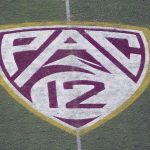As it wades across the most turbulent era in the history of college athletics, the Pac-12 is drifting ever closer to an existential crisis.
It has nothing to do with conference realignment — with poaching by the Big Ten or SEC — and everything to do with talent acquisition.
With recruiting elite prospects in the era of name, image and likeness (NIL).
NIL grants athletes in all sports the right to receive uncapped compensation for promotional and endorsement endeavors, so long as the payments don’t come directly from the university.
It became the law of the land last summer and has created a lawless land.
In the world of NIL, the rules of engagement are blurred, NCAA oversight is non-existent, and the cheating that used to occur under the table is now in plain sight — inevitable, unstoppable and, it appears, perfectly acceptable.
NIL opportunities weren’t supposed to be dangled as recruiting inducements for transfers or high school players but … wouldn’t you know it … are being dangled as recruiting inducements for transfers and high school players.
In fact, that has quickly become their primary purpose.
And at the highest levels of Pac-12 power, there are questions about the path forward — and if there should even be a path forward.
Should the schools become immersed in aspects of NIL that contradict the spirit of amateurism still alive in Ivory Towers across the conference?
“Some schools want to pursue football and basketball at the highest level,’’ a source said. “Other schools think that approach is destructive.”
If NIL remains unchecked for years to come — the NCAA has asked Congress for help regulating the marketplace — the Pac-12 eventually could cease to exist as we know it.
A split into divisions based on donor support for NIL was one of several possible outcomes, but hardly the most extreme, offered to the Hotline by conference sources and NIL experts. (One source wondered if schools would simply stop playing major college football.)
Why donor support?
Because after eight months of NIL, the so-called donor collectives (or consortiums) have emerged as the prime movers in the marketplace — the fundamental drivers of recruiting.
How do they work? Typically, a group of donors or local business leaders will pool their resources and offer compensation to players for promotional opportunities that take little effort but pay well.
For example, the ‘Horns With a Heart’ program reportedly will pay each Texas offensive lineman $50,000 to support charitable causes. The founders are UT alumni and supporters.
Or consider Miami, where John Ruiz, a local businessman, is paying 10 Hurricane players between $30,000 and $50,000 to promote his company, Life Wallet.
Technically, Ruiz is unaffiliated with the university and coach Mario Cristobal’s program. In reality, Cristobal’s recruiting efforts benefit immensely.
From coast to coast, recruits are no longer asking about playing time or jersey numbers. They’re asking about NIL numbers — the amount of compensation available for doing something, or nothing, once they join a program.
Within the Pac-12, USC quarterback Caleb Williams has the highest-profile NIL deal; he signed with Beats By Dre for an undisclosed amount.
But that’s an outlier: Williams was the top quarterback on the transfer market, a potential Heisman Trophy candidate who signed with an established company.
It’s not the same as a backup offensive lineman getting $50,000 for undisclosed charitable endeavors from a donor consortium in Austin.
Williams’ deal reflects the NIL marketplace as originally envisioned by the NCAA when it capitulated on all attempts at regulation.
And to be clear: Some donor collectives are entirely legitimate, offering local business opportunities that clear a high ethical threshold.
Other collectives are merely fronts for pay-for-play.
Guess which are more popular with recruits?
“The Pac-12 has always thought it’s above that stuff, that it doesn’t need to step down into the dirt,” a conference source said. “You know, ‘We’re the Conference of Champions’ stuff.”
Some presidents and chancellors “feel like there are other uses for donor money” and “are ambivalent” about plunging into the world of donor collectives, another source said.
Which ones? There’s a rough “correlation to academics.”
Unless Congress intervenes, nothing will derail the donor collectives from gaining further control of the NIL marketplace and, by extension, the talent acquisition process.
Does the Pac-12 have enough donors at enough schools willing to offer enough cash to materially improve recruiting — all while ensuring the business relationships are above board, however that board is defined?
We’ll know more by next winter, at the conclusion of the first full recruiting cycle in the NIL era.
“The Pac-12, as in most things, will play by the rules more than other conferences, which will hurt them in a very big way,” an industry source said.
“NIL could and should be an advantage but will end up being a disadvantage.”
Support the Hotline: Receive three months of unlimited access for just 99 cents. Yep, that’s 99 cents for 90 days, with the option to cancel anytime. Details are here, and thanks for your support.
*** Send suggestions, comments and tips (confidentiality guaranteed) to pac12hotline@bayareanewsgroup.com or call 408-920-5716
*** Follow me on Twitter: @WilnerHotline
*** Pac-12 Hotline is not endorsed or sponsored by the Pac-12 Conference, and the views expressed herein do not necessarily reflect the views of the Conference.





